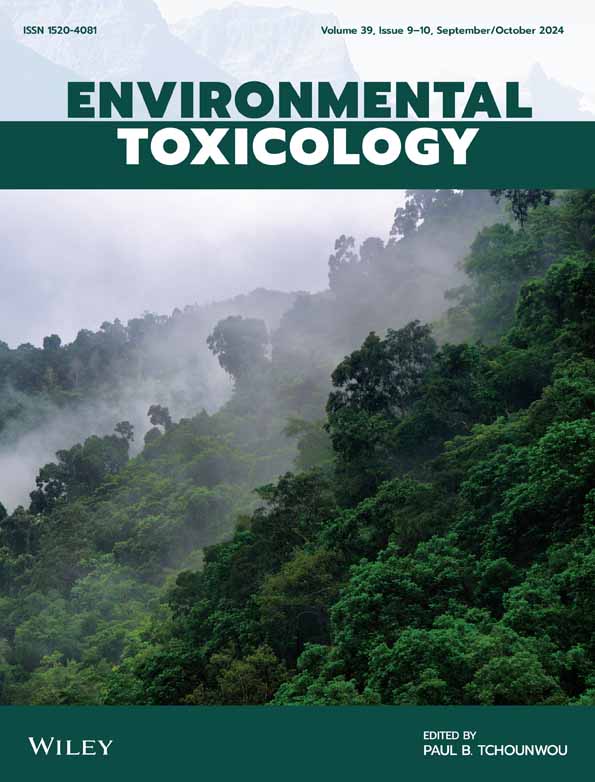多生物标志物方法研究甲氧虫酰肼对夜蛾的毒性
IF 3.2
3区 医学
Q2 ENVIRONMENTAL SCIENCES
引用次数: 0
摘要
甲氧虫酰肼是一种二酰基肼类昆虫生长调节剂,作为蜕皮激素受体激动剂,可诱导易感幼虫过早和致死性蜕皮。本研究旨在评估以甲氧虫酰肼为基础的商业杀虫剂BYPASS在暴露于0.042、0.21和0.42 mg/L亚致死浓度7天、14天和21天后对绿吻Oncorhynchus mykiss幼鱼组织多个终点的影响。CF和/或HSI没有明显变化。治疗导致脑和肌肉中乙酰胆碱酯酶活性降低,同时鳃和肾脏组织中Na+、K+‐atp酶显著下降。在整个实验过程中,各组织中抗氧化酶活性的升高伴随着TBARS和PC水平的升高,证明了氧化应激状态。暴露21天后8‐OHdG水平的升高也证实了这一点。Caspase‐3活性以组织特异性的方式上升,表明凋亡通过线粒体途径开始。多生物标志物反应在计算指标中显示出浓度依赖效应,抗氧化酶的生物标志物得分也较高。总的来说,我们揭示了BYPASS的神经毒性和促氧化活性,以及它引起DNA损伤、细胞凋亡和破坏渗透调节的能力。研究结果首次证实了甲氧虫酰肼对麦吻蝽组织的亚致死效应,增加了我们对杀虫剂所代表的风险的理解,以及对降低非目标生物风险的严格监管审查的必要性。本文章由计算机程序翻译,如有差异,请以英文原文为准。
A Multibiomarker Approach to Delineate the Toxicity of Methoxyfenozide on Oncorhynchus mykiss
Methoxyfenozide is a diacylhydrazine‐class insect growth regulator functioning as an ecdysone receptor agonist and inducing premature and lethal molt in susceptible larvae. This investigation was conducted to evaluate the impact of methoxyfenozide‐based commercial insecticide BYPASS on multiple end points in tissues of juvenile Oncorhynchus mykiss + , K+ ‐ATPase in gill and kidney tissues. The increase in the activities of antioxidant enzymes was followed by elevated levels of TBARS and PC throughout the experiment in all tissues, proving the status of oxidative stress. It is supported by the observed increase in 8‐OHdG level following 21 days of exposure. Caspase‐3 activity rose in a tissue‐specific manner indicating the initiation of apoptosis via the mitochondrial pathway. Multi‐biomarker responses showed concentration‐dependent effects in calculated indexes as well as higher biomarker scores for antioxidant enzymes. Overall, the neurotoxic potential and pro‐oxidant activity of BYPASS, along with its potency to cause DNA damage, apoptosis, and to disrupt osmoregulation, were revealed. The outcomes manifest the first experimental sublethal effects caused by methoxyfenozide in tissues of O. mykiss
求助全文
通过发布文献求助,成功后即可免费获取论文全文。
去求助
来源期刊

Environmental Toxicology
环境科学-毒理学
CiteScore
7.10
自引率
8.90%
发文量
261
审稿时长
4.5 months
期刊介绍:
The journal publishes in the areas of toxicity and toxicology of environmental pollutants in air, dust, sediment, soil and water, and natural toxins in the environment.Of particular interest are:
Toxic or biologically disruptive impacts of anthropogenic chemicals such as pharmaceuticals, industrial organics, agricultural chemicals, and by-products such as chlorinated compounds from water disinfection and waste incineration;
Natural toxins and their impacts;
Biotransformation and metabolism of toxigenic compounds, food chains for toxin accumulation or biodegradation;
Assays of toxicity, endocrine disruption, mutagenicity, carcinogenicity, ecosystem impact and health hazard;
Environmental and public health risk assessment, environmental guidelines, environmental policy for toxicants.
 求助内容:
求助内容: 应助结果提醒方式:
应助结果提醒方式:


